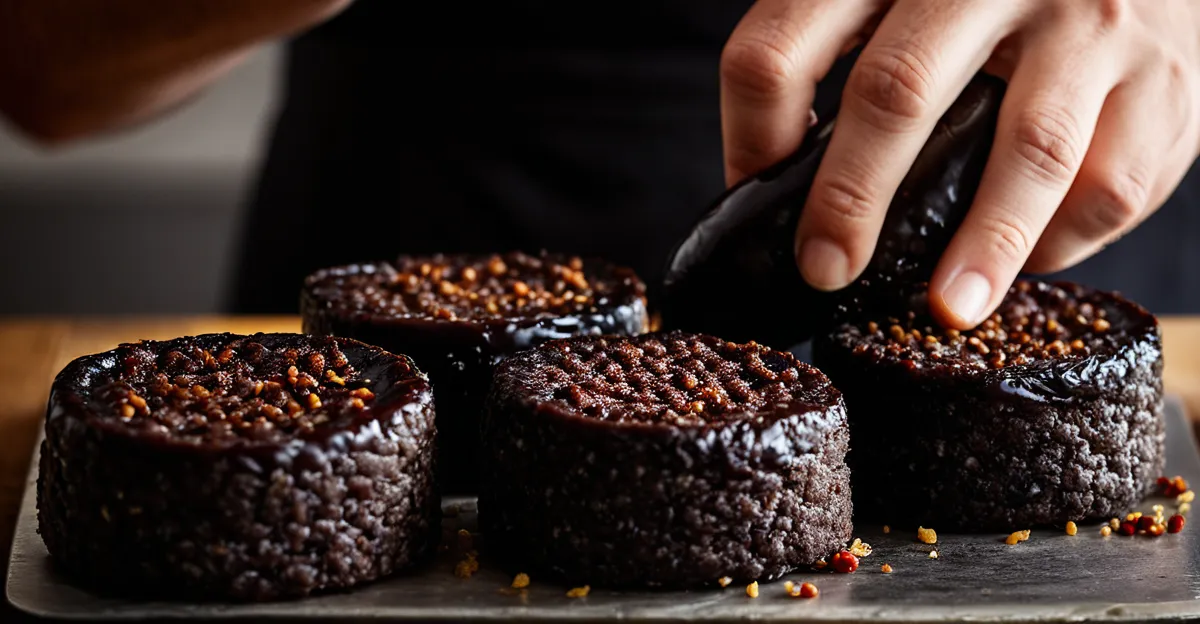Essential Ingredients and Sourcing for Authentic Black Pudding
Understanding the traditional black pudding ingredients is crucial to creating an authentic product. The core components always include pork blood, oatmeal, fat, and barley. These combine to provide the distinctive texture and rich flavor associated with black pudding. Additionally, black pudding spices play an essential role; typical seasonings vary by region but often include herbs like marjoram, black pepper, and nutmeg, which elevate the flavor while respecting tradition.
Sourcing quality pork blood is vital. Freshness directly affects taste and safety, as pork blood spoils quickly. Preferably, pork blood should be obtained from local butchers who maintain strict hygiene standards. For those who cannot access local sources, reputable online suppliers offer frozen pork blood, maintaining integrity during shipment.
Also to read : How Can Traditional UK Dishes Be Adapted for Modern Tastes?
Equally important is the oatmeal and barley, which must be fresh and properly prepared to ensure the right texture and binding capacity. Using stale or low-quality grains can result in a subpar product. Variations in ingredient ratios and spices reflect regional preferences, but adherence to fresh, traditional components remains a constant for true authenticity.
Preparation Techniques for Traditional Black Pudding Mixture
Achieving the correct black pudding consistency starts with properly preparing the oatmeal. Traditionally, oatmeal or barley must be soaked or lightly cooked before mixing to avoid a gritty texture. This step helps the grains absorb moisture, enabling them to bind well with the other ingredients, particularly pork blood and fat, essential for authentic black pudding texture.
Additional reading : What are the key steps to preparing a traditional Scottish haggis?
When mixing black pudding, combine the soaked grains with fresh pork blood, rendered fat, and carefully measured black pudding spices. The spices must be balanced to maintain authenticity—too much overwhelms, too little dulls flavor. Marjoram, black pepper, and nutmeg are commonly used, reflecting traditional seasoning profiles.
The mixing process requires gentle but thorough blending to distribute ingredients uniformly without causing the mixture to become overly wet or dry. Consistency should be sticky but not runny, allowing it to hold shape when filled into casings.
In summary, the key steps are:
- Soak oatmeal or barley adequately
- Add pork blood and fat in balanced amounts
- Incorporate traditional black pudding spices carefully
- Mix to a cohesive, malleable consistency
This preparation approach ensures the resulting black pudding has the intended texture, flavor depth, and overall quality cherished in traditional recipes.
Cooking Methods and Achieving Optimal Texture
Mastering black pudding cooking methods is essential for authentic texture and flavor. After mixing black pudding to the correct consistency, the mixture is traditionally filled into natural casings. Ensuring the casing is evenly packed without air pockets prevents splitting during cooking. Overfilling can cause bursts, while underfilling leads to uneven texture.
Poaching black pudding at a gentle temperature, typically between 80°C and 85°C (176°F to 185°F), is crucial. This slow cooking allows the proteins from the pork blood and oatmeal to coagulate properly, resulting in the ideal firmness without drying out. Cooking times vary but generally last 45 to 60 minutes, depending on thickness.
To check doneness, gently press the black pudding; it should feel firm but springy. Overcooking risks toughness and moisture loss, while undercooking leaves a raw, crumbly interior. Some prefer finishing by lightly frying slices, which enhances flavor and creates a crisp crust while preserving the moist interior texture.
These cooking techniques, combined with precise temperature control and careful handling during filling, achieve that sought-after texture perfection prized in traditional black pudding recipes.
Common Problems, Food Safety, and Troubleshooting
Handling pork blood safely is paramount to avoid contamination. Always source fresh pork blood from trustworthy suppliers who adhere to hygiene standards. Keep blood refrigerated below 4°C and use it promptly to prevent spoilage, as rancid blood can cause off-flavors and pose health risks.
Common black pudding troubleshooting issues include splitting casings and poor binding. Splitting often results from overfilling or uneven casing packing; ensure casings are filled firmly but not stretched. To improve binding, verify the black pudding consistency is sticky yet malleable—too much liquid or insufficient oatmeal preparation can cause crumbling.
Blandness is another frequent problem in traditional recipes. Carefully balance your black pudding spices, such as marjoram and black pepper, during mixing black pudding. Insufficient seasoning dulls flavor, but excessive spices overwhelm the dish. Taste testing small portions beforehand can help perfect seasoning.
Other black pudding tips include monitoring poach temperature to prevent drying out and avoiding prolonged exposure to air which hardens texture. Maintaining ingredient freshness and precise preparation will minimize most problems, ensuring a safer, tastier black pudding.
Serving Suggestions and Storing Homemade Black Pudding
When serving black pudding, traditional accompaniments enhance its rich, savory flavor. It pairs excellently with fried eggs, sautéed apples, or mustard, commonly featured in classic breakfasts. Slices should be cut about 1cm thick for optimal frying, allowing a crisp exterior while maintaining a moist interior. Lightly frying in a small amount of fat releases the aromatic spices and creates a desirable crust.
For reheating, gentle methods preserve texture. Avoid microwaving as it can dry out the pudding. Instead, reheat slices slowly in a pan over low heat or in an oven set to a moderate temperature. This gradual warming helps retain moisture and flavor integrity.
Storage tips are essential for maintaining freshness. Store unopened black pudding in the refrigerator and consume within a few days to prevent spoilage. Once opened, tightly wrap and use promptly. Black pudding freezes well, extending shelf life by up to three months—slice before freezing for convenience. Defrost in the refrigerator overnight for best quality.
Proper serving and storage not only uphold the traditional eating experience but also ensure food safety and prolong usability, making homemade black pudding a versatile and delightful dish.
Historical and Regional Insights into Traditional Black Pudding
Black pudding has a rich history dating back centuries, originating from ancient blood sausage traditions found across Europe. It evolved as a practical way to use all parts of slaughtered animals, particularly during colder months when preservation was crucial. This method of combining pork blood with grains like barley and oatmeal allowed communities to create a nutritious, long-lasting food source.
Regional black pudding variations reflect local ingredients and cultural preferences. For example, in Ireland and Northern England, the recipe emphasizes finely milled oatmeal and herbs such as marjoram, while Spanish versions—known as morcilla—often include rice and additional spices like paprika. Scotland favors a coarser oatmeal texture, lending a heartier bite.
The cultural significance of black pudding varies but often ties to traditional celebrations such as harvest festivals and communal feasts. It represents a symbol of resourcefulness and local identity. Understanding these historical and regional differences enriches appreciation for the diversity within seemingly simple traditional black pudding ingredients and supports greater respect for authentic preparation methods. This recognition ensures that each variety maintains its unique place in culinary heritage.



